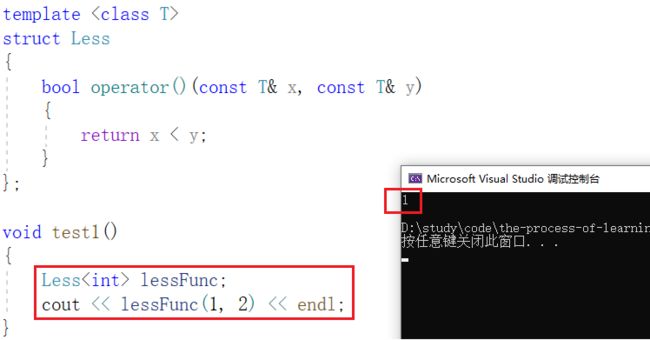【C++】优先级队列与仿函数
目录
一、优先级队列介绍与使用
1、priority_queue介绍
2、priority_queue的使用
二、仿函数
1、仿函数编写与使用
三、priority_queue模拟实现
四、扩展内容
一、优先级队列介绍与使用
1、priority_queue介绍
1、优先队列是一种容器适配器,根据严格的弱排序标准,它的第一个元素总是它所包含的元素中最大的。
2、此上下文类似于堆,在堆中可以随时插入元素,并且只能检索最大堆元素(优先队列中位于顶部的元素)。
3、优先队列被实现为容器适配器,容器适配器即将特定容器类封装作为其底层容器类,queue提供一组特定的成员函数来访问其元素。元素从特定容器的“尾部”弹出,其称为优先队列的顶部。
4、底层容器可以是任何标准容器类模板,也可以是其他特定设计的容器类。容器应该可以通过随机访问迭代器访问,并支持以下操作:
- empty():检测容器是否为空
- size():返回容器中有效元素个数
- front():返回容器中第一个元素的引用
- push_back():在容器尾部插入元素
- pop_back():删除容器尾部元素
5、标准容器类vector和deque满足这些需求。默认情况下,如果没有为特定的priority_queue类实例化指定容器类,则使用vector。
6、需要支持随机访问迭代器,以便始终在内部保持堆结构。容器适配器通过在需要时自动调用算法函数make_heap、push_heap和pop_heap来自动完成此操作。
2、priority_queue的使用
优先级队列默认使用vector作为其底层存储数据的容器,在vector上又使用了堆算法将vector中元素构造成堆的结构,因此priority_queue就是堆,所有需要用到堆的位置,都可以考虑使用priority_queue。注意:默认情况下priority_queue是大堆。
| 函数声明 | 接口说明 |
| priority_queue()/priority_queue(first, last) |
构造一个空的优先级队列 |
| empty( ) | 检测优先级队列是否为空,是返回true,否则返回 false |
| top( ) | 返回优先级队列中最大(最小元素),即堆顶元素 |
| push(x) | 在优先级队列中插入元素x |
| pop() | 删除优先级队列中最大(最小)元素,即堆顶元素 |
可以看到 priority_queue 默认较大的数字优先级更高,即默认为大堆。
如果想要使优先级队列中,小的优先级更高,则可以借助仿函数来实现。
二、仿函数
使用仿函数需要包含头文件 functional 。
可以实现优先级队列中小的优先级更高。
1、仿函数编写与使用
仿函数有一个特点,就是都重载了一个 "()" 运算符:
template
struct Less
{
bool operator()(const T& x, const T& y)
{
return x < y;
}
}; 使用方法如下:
看 lessFunc 的用法,他好像是一个函数,但实际上他是一个类实例化出的对象。我们把这个类称为仿函数,仿函数的对象可以像函数一样使用。
三、priority_queue模拟实现
priority_queue的底层是使用堆来实现的,具体关于堆的内容可以参考文章《堆——一种特殊的二叉树结构》。
具体代码如下:
namespace bin
{
template
struct less
{
bool operator()(const T& x, const T& y)
{
return x < y;
}
};
template
struct greater
{
bool operator()(const T& x, const T& y)
{
return x > y;
}
};
template, class Compare = less>
class priority_queue
{
public:
void adjust_up(int child)
{
Compare com;
int parent = (child - 1) / 2;
while (child > 0)
{
//if (_con[parent] < _con[child])
if (com(_con[parent], _con[child]))
{
swap(_con[child], _con[parent]);
child = parent;
parent = (child - 1) / 2;
}
else
{
break;
}
}
}
void adjust_down(int parent)
{
int child = parent * 2 + 1;
while (child < _con.size())
{
Compare com;
//if (child + 1 < _con.size() && _con[child] < _con[child + 1])
if (child + 1 < _con.size() && com(_con[child], _con[child + 1]))
{
++child;
}
//if (_con[parent] < _con[child])
if (com(_con[parent], _con[child]))
{
swap(_con[child], _con[parent]);
parent = child;
child = parent * 2 + 1;
}
else
{
break;
}
}
}
void push(const T& x)
{
_con.push_back(x);
adjust_up(_con.size() - 1);
}
void pop()
{
swap(_con[0], _con[_con.size() - 1]);
_con.pop_back();
adjust_down(0);
}
const T& top()
{
return _con[0];
}
size_t size()
{
return _con.size();
}
bool empty()
{
return _con.empty();
}
private:
Container _con;
};
} 测试结果正确:
四、扩展内容
对于仿函数,我们可以自由的指定其比较方式,如以下场景:
class Date
{
public:
Date(int year = 1900, int month = 1, int day = 1)
: _year(year)
, _month(month)
, _day(day)
{}
bool operator<(const Date& d)const
{
return (_year < d._year) ||
(_year == d._year && _month < d._month) ||
(_year == d._year && _month == d._month && _day < d._day);
}
bool operator>(const Date& d)const
{
return (_year > d._year) ||
(_year == d._year && _month > d._month) ||
(_year == d._year && _month == d._month && _day > d._day);
}
friend ostream& operator<<(ostream& _cout, const Date& d)
{
_cout << d._year << "-" << d._month << "-" << d._day;
return _cout;
}
private:
int _year;
int _month;
int _day;
};
class PDataLess
{
public:
bool operator()(const Date* p1, const Date* p2)
{
return *p1 < *p2;
}
};
class PDataGreater
{
public:
bool operator()(const Date* p1, const Date* p2)
{
return *p1 > *p2;
}
};
void TestPriorityQueue()
{
priority_queue, PDataGreater> q;
q.push(new Date(2023, 4, 8));
q.push(new Date(2023, 4, 9));
q.push(new Date(2023, 4, 7));
cout << q.top() << endl;
} 我们设定的优先级队列的成员变量类型为指针类型,但是我们希望他们的比较方案是比较他们解引用后的数据,这就可以通过设置仿函数内的比较策略来完成目的:
关于优先级队列的内容就讲到这里,希望同学们多多支持,如果有不对的地方欢迎大佬指正,谢谢!





